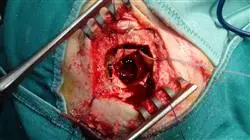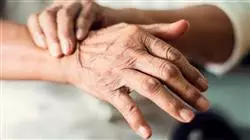University certificate
The world's largest faculty of medicine”
Why study at TECH?
Knowing about advances in neurology will enable physicians to stay abreast of the latest techniques on offer for the diagnosis of potential neurodevelopmental diseases and prescribe more effective treatments"

Neurological Diagnosis has evolved exponentially in recent decades. The introduction of new and sophisticated technologies applied to this field drives and facilitates the development of research. Keeping up with this unstoppable flow of information can be a daunting task, but it is absolutely necessary. In this comprehensive Advanced master’s degree, we invite you to the forefront of this specialty where we will bridge the gap between highly specialized fields of Neurology and Neurodevelopment. This is all done thanks to the most complete training on the market, which we have divided into two main blocks of study. On the one hand, Pediatric Neurology and Neurodevelopment, and on the other hand, neurology updates. A way of organizing the information that will make the study of the main novelties in this field much more comprehensible.
It is necessary to understand that general practitioners cannot encompass the complexity of all pediatric subspecialties. As they progress and develop as professionals, each one acquires a specific body of knowledge and chooses their own specialty. In addition, the nuances of child development depending on the age and numerous other factors requires a great deal of specialization on the part of medical professionals working in the field of neurology.
For this very reason, the neurology specialist needs to keep up to date with their area of knowledge, so that they can act efficiently and offer their patients the latest advancements in their clinical practice. However, accessing the latest scientific evidence and keeping up to date with it can be difficult when attempting to balance a professional and personal life, as it requires a level of time and dedication that, on occasions, the specialist does not have.
This Advanced master’s degree offers the possibility to deepen and update knowledge of this field, with the use of the latest educational technology. It provides a comprehensive overview of Neurology and Neurodevelopment, while focusing on the most important and innovative aspects of treatments in pediatric neurology. All this in a 100% online training, which will allow you to expand your knowledge and, therefore, your professional skills and competencies in a simple way, adapting your study time to the rest of your daily obligations.
This program has been designed for professionals seeking the highest qualification, with the best didactic material, working on real clinical cases and learning from the best professionals in the sector"
This Advanced master’s degree in Neurology and Neurodevelopment contains the most complete and up-to-date program on the market. The most important features include:
- The development of clinical cases presented by experts in Neurology and Neurodevelopment
- The graphic, schematic, and eminently practical contents with which they are created, provide scientific and practical information on the disciplines that are essential for professional practice
- New diagnostic and therapeutic developments in Neurology and Neurodevelopment
- The presentation of hands-on workshops on procedures, diagnostic and therapeutic techniques
- Contains real images in high resolution and practical exercises where the self-evaluation process can be carried out to improve learning
- An algorithm-based interactive learning system for decision-making in the clinical situations presented throughout the course
- Special emphasis on test-based medicine and research methodologies
- Theoretical lessons, questions to the expert, debate forums on controversial topics, and individual reflection assignments
- Content that is accessible from any fixed or portable device with an Internet connection
Our Advanced master’s degree is a unique opportunity to study, the most relevant aspects in Neurology and Neurodevelopment, training you further so as to give your career a boost"
Its teaching staff includes health professionals from the medical field, who contribute their work experience to this training, as well as renowned specialists from leading scientific societies.
The multimedia content, developed with the latest educational technology, will provide the professional with situated and contextual learning, i.e., a simulated environment that will provide an immersive training program designed to train for real life situations.
This program is designed around Problem-Based Learning, whereby the Doctor must try to solve different professional practice situations that arise during the program. For this purpose, the professional will be assisted by an innovative interactive video system created by renowned and experienced experts in the field of Neurology and Neurodevelopment with extensive teaching experience.
Increase your decision-making confidence by updating your knowledge through this Advanced master’s degree, a program created to train the best"

We offer you the best teaching methodology, with a multitude of practical contents that will allow you to study in a more complete and effective way"
Syllabus
The structure of the contents has been designed by a team of professionals from the best research centers and universities on a national level. Aware of the relevance of current training and the need to support each study and its application on a solid scientific basis, based on evidence, they have created a didactic path in which each topic will address one of the relevant aspects in the knowledge of a highly competent professional. All these factors have produced a highly intense syllabus of unmatched quality, which combines theory with state-of-the-art, to propel you towards a new level of mastery in the sector.

This Advanced master’s degree is an unparalleled opportunity to get, on one unique course, all the necessary knowledge in Neurology and Neurodevelopment, including the most recent advances in intervention techniques and protocols"
Module 1. Update in Neurology Consultations
1.1. Medical History in Pediatric Neurology
1.1.1. Clinicians Personal Skills
1.1.2. Advantages and Disadvantages of Good Communication and Information
1.1.3. Orientation of the Medical History according to Disorders
1.1.3.1. Headaches
1.1.3.2. Epilepsy
1.1.4. Orientation of the Medical History according to Age
1.1.4.1. Prenatal Medical History
1.1.4.2. Neonatal Medical History
1.1.4.3. Medical History in Young Children
1.1.4.4. Medical History in Older Children
1.1.5. Medical History of Psychomotor Development
1.1.6. Medical History of Language Development
1.1.7. History of the Mother/Father-Child Bond
1.1.8. Personal and Family History
1.2. Neurological Examination of Newborns and Infants
1.2.1. Basic Neurological Examination
1.2.2. General Data
1.2.3. External Aspect
1.2.4. Functional Behaviors
1.2.5. Sensory Functions
1.2.6. Motility
1.2.7. Primary Reflexes and Postural Attitudes
1.2.8. Tone, Hand Pressure, and Manipulation
1.2.9. Cranial Nerves
1.2.10. Sensitivity
1.2.11. Neurological Assessment Scales
1.3. Neurological Examination of Older Children
1.4. Neuropsychological Examination of Preschool Children
1.4.1. The 3 First Years of Life
1.4.2. Development
1.4.3. First Trimester
1.4.4. 3-6 Month Period
1.4.5. 6-9 Month Period
1.4.6. 9-12 Month Period
1.4.7. 12-18 Month Period
1.4.8. 18-24 Month Period
1.4.9. 24-36 Month Period
1.5. Neuropsychological Examination of School Children
1.5.1. Evolution from Age 3 to 6
1.5.2. Development
1.5.3. Cognitive Assessment
1.5.4. Language Evaluation
1.5.5. Attention Evaluation
1.5.6. Memory Evaluation
1.5.7. Evaluation of Psychomotor Skills and Rhythm
1.6. Psychomotor Development
1.6.1. The Concept of Psychomotor Development
1.6.2. Psychomotor Development Evaluation
1.6.3. Warning Signs in Psychomotor Development Evaluation
1.6.4. Psychomotor Development Evaluation Scales
1.7. Complementary Evaluations
1.7.1. Prenatal Diagnosis
1.7.2. Genetic Studies
1.7.3. Biochemical Studies
1.7.3.1. Blood
1.7.3.2. Urine
1.7.4. Cerebrospinal Fluid
1.7.5. Diagnostic Imaging
1.7.5.1. Ultrasound
1.7.5.2. CAT
1.7.5.3. Magnetic Resonance
1.7.5.4. Positron Emission Tomography (PET)
1.7.5.5. Single Photon Emission Computed Tomography (SPECT)
1.7.5.6. Magnetoencephalography
1.7.6. Neurophysiological Studies
1.7.6.1. Electroencephalogram
1.7.6.2. Visual Evoked Potential of the Torso and Somatosensation
1.7.6.3. Electroneurogram (ENG)
1.7.6.4. Electromyogram (EMG)
1.7.6.5. Nerve Conduction Velocity (NCV)
1.7.6.6. Single Fiber Study
Module 2. Advances in Prenatal and Neonatal Neurology
2.1. Prenatal Central Nervous System Infections
2.1.1. Introduction
2.1.2. General Pathogenic Aspects
2.1.3. Congenital Viral Infections
2.1.3.1. Cytomegalovirus
2.1.3.2. Rubella
2.1.3.3. Herpes
2.1.4. Congenital Bacterial Infections
2.1.4.1. Syphilis
2.1.4.2. Listeria
2.1.4.3. Lyme Disease
2.1.5. Congenital Infections due to Parasites
2.1.5.1. Toxoplasma
2.1.6. Other Infections
2.2. Vascular
2.2.1. Introduction
2.2.2. The Embryonic Process and its Disorders
2.2.3. Main CNS Abnormalities
2.2.3.1. Dorsal Induction Abnormalities
2.2.3.2. Ventral Induction Abnormalities
2.2.3.3. Midline Alterations
2.2.3.4. Cell Proliferation-Differentiation Abnormalities.
2.2.3.5. Neuronal Migration Abnormalities
2.2.3.6. Abnormalities of the Posterior Fossa Structure
2.2.4. Embryopathies and Fetopathies
2.3. Perinatal Trauma
2.3.1. Perinatal Neurological Trauma
2.3.2. Hypoxic-Ischemic Encephalopathy
2.3.2.1. Concept, Classification and Pathophysiology
2.3.2.2. Detection, Management and Prognosis
2.3.2.3. Newborn Intracranial Hemorrhage
2.3.2.4. Germinal Matrix Hemorrhage-Intraventricular Hemorrhage
2.3.2.5. Periventricular Hemorrhagic Infarction
2.3.2.6. Cerebellar Hemorrhage
2.3.2.7. Supratentorial Hemorrhage
2.4. Neonatal Metabolic Disorders with Neurological Effects
2.4.1. Introduction
2.4.2. Neonatal Screening for Inborn Errors of Metabolism
2.4.3. Diagnosis of Metabolic Disease in the Neonatal Period
2.4.4. Neonatal Metabolic Disease with Seizures
2.4.5. Neonatal Metabolic Disease with Neurological Deterioration
2.4.6. Neonatal Metabolic Disease with Hypotonia
2.4.7. Neonatal Metabolic Disease with Dysmorphias
2.4.8. Neonatal Metabolic Disease with Heart Disease
2.4.9. Neonatal Metabolic Disease with Hepatic Symptoms
2.5. Neonatal Seizures
2.5.1. Introduction to Neonatal Crises
2.5.2. Etiology and Pathophysiology
2.5.3. Definition and Characteristics of Neonatal Crises
2.5.4. Classification of Neonatal Crises
2.5.5. Clinical Manifestations
2.5.6. Diagnosis of Neonatal Crises
2.5.7. Treatment of Neonatal Crises
2.5.8. Prognosis of Neonatal Crises
2.6. Neonatal Intracranial Infections
2.7. Newborns at High Neurological Risk
2.7.1. Concept
2.7.2. Causes
2.7.3. Detection
2.7.4. Monitoring
Module 3. Advances in Central and Peripheral Motor Disorders
3.1. Cerebral Palsy
3.1.1. Concept
3.1.2. Etiology and Risk Factors
3.1.2.1. Prenatal Factors
3.1.2.1.1. Perinatal Factors
3.1.2.1.2. Postnatal Factors
3.1.2. Clinical Forms
3.1.2.1. Spastic ICP
3.1.2.2. Spastic Diplegia
3.1.2.3. Spastic Hemiplegia
3.1.2.4. Spastic Triplegia
3.1.2.5. Dyskinetic or Athetoid ICP
3.1.2.6. Ataxic ICP
3.1.3. Comorbid Disorders
3.1.4. Microbiological
3.1.5. Treatment
3.2. Motor Neuron Diseases in Childhood
3.2.1. Generalized Forms of Motor Neuron Diseases
3.2.1.1. Spinal Muscular Atrophy
3.2.1.2. Other Variations of Spinal Muscular Atrophy
3.2.2. Focal Forms of Motor Neuron Diseases in Childhood
3.3. Juvenile Myasthenia Gravis and Other Neuromuscular Junction Disorders
3.3.1. Juvenile Myasthenia Gravis in Childhood
3.3.2. Transient Neonatal Myasthenia Gravis
3.3.3. Congenital Myasthenic Syndromes
3.3.4. Childhood Botulism
3.4. Childhood Muscular Dystrophy
3.4.1. Childhood Muscular Dystrophy: Dystrophinopathies
3.4.2. Childhood Muscular Dystrophies Other than Dystrophinopathies
3.5. Childhood Myotonic Disorders
3.5.1. Childhood Congenital Myopathies
3.5.2. Childhood Inflammatory and Metabolic Myopathies
3.6. Childhood Neuropathies
3.6.1. Motor Neuropathies
3.6.2. Sensorimotor Neuropathies
3.6.3. Sensory Neuropathies
Module 4. Update on Inborn Errors of Metabolism
4.1. Introduction to Inborn Errors of Metabolism
4.1.1. Introduction and Concept
4.1.2. Etiology and Classification
4.1.3. Clinical Manifestations
4.1.4. General Diagnostic Process
4.1.5. General Intervention Guidelines
4.2. Mitochondrial Diseases
4.2.1. Oxidative Phosphorylation Defects
4.2.2. Krebs Cycle Defect
4.2.3. Etiology and Pathophysiology
4.2.4. Classification
4.2.5. Microbiological
4.2.6. Treatment
4.3. Fatty Acid ß-Oxidation Defects
4.3.1. Introduction to Beta-Oxidation Disorders
4.3.2. Pathophysiology of Beta-Oxidation Disorders
4.3.3. Clinical Manifestations of Beta-Oxidation Disorders
4.3.4. Diagnosis of Beta-Oxidation Disorders
4.3.5. Treatment of Beta-Oxidation Disorders
4.4. Gluconeogenesis Defects
4.4.1. Etiology and Pathophysiology
4.4.2. Classification
4.4.3. Microbiological
4.4.4. Treatment
4.5. Peroxisomal Diseases
4.5.1. Zellweger Syndrome
4.5.2. X-linked Adrenoleukodystrophy
4.5.3. Other Peroxisomal Diseases
4.6. Congenital Glycosylation Defects
4.6.1. Etiology and Pathophysiology
4.6.2. Classification
4.6.3. Microbiological
4.6.4. Treatment
4.7. Neurotransmitter CMD
4.7.1. Introduction to Neurotransmitter Metabolic Diseases
4.7.2. General Concepts of Neurotransmitter Metabolic Diseases
4.7.3. Disorders of GABA Metabolism
4.7.4. Biogenic Amine Disorder
4.7.5. Startle Disease or Hereditary Hyperekplexia
4.8. Creatine Brain Defects
4.8.1. Etiology and Pathophysiology
4.8.2. Classification
4.8.3. Microbiological
4.8.4. Treatment
4.9. Aminoacidopathies
4.9.1. Phenylketonuria.
4.9.2. Hyperphenylalaninemia
4.9.3. Tetrahydrobiopterin Deficiency
4.9.4. Non-Ketotic Hyperglycemia
4.9.5. Maple Syrup Urine Disease
4.9.6. Homocystinuria
4.9.7. Tyrosinemia Type II
4.10. IEM of Purines and Pyrimidines
4.10.1. Etiology and Pathophysiology
4.10.2. Classification
4.10.3. Microbiological
4.10.4. Treatment
4.11. Lysosomal Diseases
4.11.1. Mucopolysaccharidosis
4.11.2. Oligosaccharidosis
4.11.3. Sphingolipidosis
4.11.4. Other Lysosomal Diseases
4.12. Glycogenosis
4.12.1. Etiology and Pathophysiology
4.12.2. Classification
4.12.3. Microbiological
4.12.4. Treatment
4.13. Organic Acidemias
4.13.1. Methylmalonic Acidemia
4.13.2. Propionic Acidemia
4.13.3. Isovaleric Acidemia
4.13.4. Glutaric Aciduria Type I
4.13.5. 3-Methyl Crotonyl Glyciduria
4.13.6. Holocarboxylase Synthetase Deficiency
4.13.7. Biotinidase Deficiency
4.13.8. 3-Methylglutaconyl Aciduria Type I
4.13.9. 3-Methylglutaconyl Aciduria Type III
4.13.10. D-2 Hydroxyglutaric Aciduria
4.13.11. L-2 Hydroxyglutaric Aciduria
4.13.12. 4-Hydroxybutyric Aciduria
4.13.13. Deficiency of Acetoacetyl CoA-Thiolase
4.14. IEM of Carbohydrates
4.14.1. Etiology and Pathophysiology
4.14.2. Classification
4.14.3. Microbiological
4.14.4. Treatment
Module 5. Advances in Developmental, Learning and Neuropsychiatric Disorders
5.1. Delayed Psychomotor Development
5.1.1. Concept
5.1.2. Etiology
5.1.3. Epidemiology
5.1.4. Symptoms
5.1.5. Microbiological
5.1.6. Treatment
5.2. Generalized Developmental Disorders
5.2.1. Concept
5.2.2. Etiology
5.2.3. Epidemiology
5.2.4. Symptoms
5.2.5. Microbiological
5.2.6. Treatment
5.3. Attention Deficit and Hyperactivity Disorder
5.3.1. Concept
5.3.2. Etiology
5.3.3. Epidemiology
5.3.4. Symptoms
5.3.5. Microbiological
5.3.6. Treatment
5.4. Eating Disorders
5.4.1. Introduction: Anorexia, Bulimia and Binge Eating Disorder
5.4.2. Concept
5.4.3. Etiology
5.4.4. Epidemiology
5.4.5. Symptoms
5.4.6. Microbiological
5.4.7. Treatment
5.5. Sphincter Control Disorder
5.5.1. Introduction: Primary Nocturnal Enuresis and Encopresis
5.5.2. Concept
5.5.3. Etiology
5.5.4. Epidemiology
5.5.5. Symptoms
5.5.6. Microbiological
5.5.7. Treatment
5.6. Psychosomatic/Functional Disorders
5.6.1. Introduction: Conversive Disorders and Simulated Disorders
5.6.2. Concept
5.6.3. Etiology
5.6.4. Epidemiology
5.6.5. Symptoms
5.6.6. Microbiological
5.6.7. Treatment
5.7. Mood Disorders
5.7.1. Introduction: Anxiety and Depression
5.7.2. Concept
5.7.3. Etiology
5.7.4. Epidemiology
5.7.5. Symptoms
5.7.6. Microbiological
5.7.7. Treatment
5.8. Schizophrenia
5.8.1. Concept
5.8.2. Etiology
5.8.3. Epidemiology
5.8.4. Symptoms
5.8.5. Microbiological
5.8.6. Treatment
5.9. Learning Disorders
5.9.1. Introduction
5.9.2. Language Disorders
5.9.3. Reading Disorder
5.9.4. Writing Disorder
5.9.5. Calculation Disorder
5.9.6. Non-Verbal Learning Disorder.
5.10. Sleep Disorders
5.10.1. Introduction
5.10.2. Conciliation Disorder
5.10.3. Fragmented Sleep Disorder
5.10.4. Delayed Sleep Cycle
5.10.5. Assessment
5.10.6. Treatment
Module 6. Update on Neurosurgical Pathology in Pediatric Neurology
6.1. Supratentorial CNS Tumors
6.2. CNS Infratentorial and Spinal Tumors
6.3. Non-Embryonal Brain Tumors in Pediatric and Adolescent Patients
6.4. Neuropsychological Assessment and Rehabilitation in Children with CNS Tumors
6.5. Non-Oncological Space Occupying Processes
6.5.1. Concept
6.5.2. Classification
6.5.3. Clinical manifestations
6.5.4. Microbiological
6.5.5. Treatment
6.6. Infantile Hydrocephalus
6.6.1. Concept and Epidemiology
6.6.2. Etiology and Pathophysiology
6.6.3. Classification
6.6.4. Clinical Manifestations
6.6.5. Microbiological
6.6.6. Treatment
6.7. Childhood Cerebrovascular Disease
6.7.1. Concept and Epidemiology
6.7.2. Etiology and Pathophysiology
6.7.3. Classification
6.7.4. Clinical manifestations
6.7.5. Microbiological
6.7.6. Treatment
Module 7. Advances in Infectious, Parainfectious, Inflammatory and/or Autoimmune Diseases of the Nervous System
7.1. Meningeal Syndrome
7.1.1. Bacterial Meningitis
7.1.2. Epidemiology
7.1.3. Hypnosis
7.1.4. Microbiological
7.1.5. Treatment
7.1.6. Acute Viral Meningitis
7.1.7. Epidemiology
7.1.8. Hypnosis
7.1.9. Microbiological
7.1.10. Treatment
7.2. Encephalitic Syndrome
7.2.1. Acute and Chronic Encephalitis
7.2.3. Epidemiology
7.2.4. Hypnosis
7.2.5. Microbiological
7.2.6. Treatment
7.2.7. Viral Encephalitis.
7.2.8. Epidemiology
7.2.9. Hypnosis
7.2.10. Microbiological
7.2.11. Treatment
7.3. Other CNS Infections
7.3.1. Fungal Infections
7.3.2. Epidemiology
7.3.3. Hypnosis
7.3.4. Microbiological
7.3.5. Treatment
7.3.6. Parasite Infections
7.3.7. Epidemiology
7.3.8. Hypnosis
7.3.9. Microbiological
7.3.10. Treatment
7.4. Demyelinating and Parainfectious Diseases
7.4.1. Acute Disseminated Encephalomyelitis (ADME)
7.4.2. Acute Postinfectious Ataxia
7.5. Toxic and Metabolic Encephalopathies
7.5.1. Classification and Types
7.5.2. Epidemiology
7.5.3. Hypnosis
7.5.4. Microbiological
7.5.5. Treatment
Module 8. Malformations, Chromosomal Alterations and Other Genetic Alterations of the CNS
8.1. Malformations of the CNS
8.1.1. Introduction
8.1.2. Classification
8.1.3. Dorsal Induction Abnormalities
8.1.4. Ventral Induction Abnormalities
8.1.5. Midline Alterations
8.1.6. Cell Proliferation-Differentiation Abnormalities
8.1.7. Neuronal Migration Abnormalities
8.1.8. Abnormalities of the Posterior Fossa Structure
8.2. Most Relevant Chromosomal Alterations in Pediatric Neurology
8.2.1. Introduction
8.2.2. Classification
8.2.3. Autosomal Aneuploidies
8.2.4. Sexual Aneuploidies
8.3. Neurocutaneous Syndromes
8.3.1. Neurofibromatosis Type I
8.3.2. Neurofibromatosis Type II
8.3.3. Tuberous Sclerosis
8.3.4. Incontinentia Pigmenti
8.3.5. Sturge-Weber Syndrome
8.3.6. Other Neurocutaneous Syndromes
8.4. Other Relevant Genetic Syndromes in Pediatric Neurology
8.4.1. Prader Willi Syndrome
8.4.2. Angelman Syndrome
8.4.3. Fragile X Syndrome
8.4.4. Williams Syndrome
8.5. Clinical Application of Genetic Studies in Neuropediatrics
8.5.1. Introduction
8.5.2. Karyotype
8.5.3. Fragile X Study
8.5.4. Subtelomeric FISH Probes
8.5.5. CGH Array
8.5.6. Exome
8.5.7. Sequencing
Module 9. Advances in Related Areas. Neuro-Ophthalmology, Neurotology, Nutrition
9.1. Neuro-Ophthalmology
9.1.1. Papillae Alterations
9.1.1.1. Congenital Abnormalities
9.1.1.2. Papillary Atrophy
9.1.1.3. Papillary Edema
9.1.2. Pupils
9.1.2.1. Anisocoria
9.1.2.2. Sympathetic Paralysis
9.1.3. Alteration of the Oculomotor Function
9.1.3.1. Ophthalmoplegia
9.1.3.2. Gaze Disorders
9.1.3.3. Apraxia
9.1.3.4. Nystagmus
9.2. Neurotology
9.2.1. Hearing
9.2.2. Exploration
9.2.3. Hearing Loss
9.2.4. Vestibular Function
9.2.5. Vestibular Function Alterations
9.3. Nutrition in Pediatric Neurology
9.3.1. Normal Nutritional Recommendations
9.3.2. Nutritional Recommendations in Neurological Disorders
9.3.3. Nutritional Supplements
9.3.4. Specific Therapeutic Diets
9.4. Pharmacology
9.4.1. Nervous System Pharmacology
9.4.2. Pharmacology in Pediatrics
9.4.3. Drugs Frequently Used in Pediatric Neurology
9.4.4. Polytherapy and Drug Resistance
9.5. Social Neuropediatrics
9.5.1. Abuse and Neglect
9.5.2. Affective and Sensory Deprivation
9.5.3. Adoption
9.5.4. Grief
Module 10. Advances in Neurological Emergencies
10.1. Status Epilepticus
10.1.1. Concept and Epidemiology
10.1.2. Etiology and Classification
10.1.3. Clinical Presentation
10.1.4. Microbiological
10.1.5. Treatment
10.2. Coma and Acute Confusional Syndrome
10.2.1. Concept and Epidemiology
10.2.2. Etiology and Classification
10.2.3. Clinical Presentation
10.2.4. Microbiological
10.2.5. Treatment
10.3. Severe Cranioencephalic Trauma
10.3.1. Concept and Epidemiology
10.3.2. Etiology and Classification
10.3.3. Clinical Presentation
10.3.4. Microbiological
10.3.5. Treatment
10.4. Acute Hemiplegia. Stroke
10.4.1. Concept and Epidemiology
10.4.2. Etiology and Classification
10.4.3. Clinical Presentation
10.4.4. Microbiological
10.4.5. Treatment
10.5. Acute Intracranial Hypertension Syndrome Valvular Dysfunction
10.5.1. Concept and Epidemiology
10.5.2. Etiology
10.5.3. Clinical Presentation
10.5.4. Microbiological
10.5.5. Treatment
10.6. Acute Spinal Cord Injury. Acute Flaccid Paralysis
10.6.1. Concept and Epidemiology
10.6.2. Etiology and Classification
10.6.3. Clinical Presentation
10.6.4. Microbiological
10.6.5. Treatment
10.7. Neurological Emergencies Pediatric Oncology
10.7.1. Fever
10.7.2. Tumor Lysis Syndrome
10.7.3. Hypercalcemia
10.7.4. Hyperleukocytosis
10.7.5. Superior Vena Cava Syndrome
10.7.6. Hemorrhagic Cystitis
Module 11. Advances in Paroxysmal Disorders
11.1. Febrile Crises
11.1.1. Introduction
11.1.2. Etiology and Genetics
11.1.3. Epidemiology and Classification
11.1.4. Symptoms
11.1.5. Microbiological
11.1.6. Treatment
11.2. Infant Epilepsies
11.2.1. West Syndrome
11.2.2. Malignant Partial Migratory Crises in Breastfeeding Infants
11.2.3. Benign Myoclonic Epilepsy in Children
11.2.4. Myoclonic Astatic Epilepsy
11.2.5. Lennox-Gastaut Syndrome
11.2.6. Benign Idiopathic Partial Epilepsies of the Infant and Toddler
11.3. School-Age Epilepsies
11.3.1. Epilepsy with Central Temporal Spikes and Related Syndromes
11.3.2. Idiopathic Occipital Epilepsies
11.3.3. Childhood Non-Idiopathic Partial Epilepsies
11.3.4. Childhood Absence Epilepsy
11.4. Epilepsy in Older Children and Adolescents
11.4.1. Juvenile Absence Epilepsy
11.4.2. Juvenile Myoclonic Epilepsy
11.4.3. Great Malaise of Awakening
11.5. Treatment of Epilepsy in Childhood
11.5.1. Introduction
11.5.2. Antiepileptic Drugs
11.5.3. The Choice of Treatment
11.5.4. The Process of Starting Treatment
11.5.5. Monitoring and Control
11.5.6. Suspending Treatment
11.5.7. Drug Resistance
11.5.8. Alternative Treatments
11.6. Headache
11.6.1. Etiology
11.6.2. Epidemiology
11.6.2. Classification
11.6.3. Microbiological
11.6.4. Complementary Tests
11.6.5. Treatment
11.7. Movement Disorders
11.7.1. Introduction
11.7.2. Classification
11.7.3. Disorders with Increased Movement
11.7.4. Dyskinetics: Tics, Chorea, and Ballismus
11.7.5. Disorders with Decreased Movement
11.7.6. Hypokinetic-Rigid Syndromes: Parkinsonism
Module 12. Diagnostic Methodology: Clinical Localization and Explorations in Clinical Research in Neurology
12.1. General Principles of Neurological Topography and Semiology
12.2. Clinical Localization of the Cerebral Hemispheres. Aphasia, Apraxia, Agnosia, and Other Disorders of Higher Cortical Functions of the Human Brain
12.3. Posterior Fossa Syndromes: Cerebellum and Brainstem
12.4. Cranial Nerves and Basic Principles of Neuro-Ophthalmology
12.5. Spinal Cord Syndromes
12.6. Explorations for Clinical Neurological Research
12.7. CSF, Laboratory, and Genetic Studies
12.8. Neuroradiology. Radioisotopic Imaging
12.9. Clinical neurophysiology
12.10. Neuropathology
Module 13. Upper and Lower Motor Neuron Diseases, Neuromuscular Plate, Peripheral Nerves, and Myopathies
13.1. Pathogenesis of Upper and Lower Motor Neuron Diseases
13.2. Classical Forms (ALS)
13.3. Variant and Genetic Forms
13.4. Peripheral Neuropathies
13.5. Genetically Determined Neuropathies
13.6. Neuropathies in Genetically Determined Systemic Diseases
13.7. Genetic Myopathies
13.8. Acquired Myopathies
13.9. Myasthenia Gravis
13.10. Other Forms of Neuromuscular Transmission Disorders
Module 14. Ischemic and Hemorrhagic Strokes. Other Neurovascular Disorders
14.1. Ischemia and Cerebral Infarction: Syndromes in Ischemic Strokes
14.2. Ischemic Strokes: Neurovascular Anatomy, Classification and Clinical Assessment
14.3. Atherosclerosis, Cardioembolic, Lacunar Syndromes, and Others
14.4. Vascular Dementia
14.5. Cerebral Hemorrhage. Hemorrhagic Strokes
14.6. Aneurysms, Vascular Malformations, Cerebral Amyloid Angiopathy
14.7. Cerebral Venous Thrombosis
14.8. Hypertensive and Anoxic Encephalopathies
14.9. Coagulation and Nervous System Disorders
14.10. Endovascular Therapy and Fibrinolysis Stroke Units
14.11. Neurorehabilitation Management of Sequelae and Control of Spasticity
Module 15. Neurodegenerative Diseases: Alzheimer's Disease and Parkinson's Disease. Other Dementias, Parkinsonisms, and Movement Disorders. Spinocerebellar Heredoataxias
15.1. Alzheimer's Disease: Macroscopic and Microscopic Findings
15.2. Alzheimer's Disease: Clinical Findings
15.3. Research and Treatment of Degenerative Dementias
15.4. Dementia and Lewy Bodies
15.5. Frontotemporal Dementia, Lobar Atrophies, Tauopathies, and Frontotemporal Lobar Degeneration with Immunoreactive Changes
15.6. Parkinson's Disease
15.7. Other Parkinsonisms
15.8. Primary and Secondary Dystonia
15.9. Choreiform and Ballistic Syndromes
15.10. Spinocerebellar Heredoataxias
Module 16. Trauma of the Nervous System. Neuro-oncology: Tumors and Paraneoplastic and Cerebellar Syndromes. Neurocutaneous Syndromes and Neurodevelopmental Disorders
16.1. Neurotraumatology: Brain and Spinal Trauma
16.2. Intracranial Tumors
16.3. Spinal Tumors
16.4. Metastases. Paraneoplastic and Cerebellar Syndromes
16.5. Malformations and Familial Syndromes: Neural Tube Defects, Spina Bifida, Chiari Malformation, Dandy-Walker, Lhermitte-Duclos Agenesis of the Corpus Callosum and Septum Pellucidum
16.6. Neuronal Migration Disorders, Heterotopias Arachnoid Cysts, Porencephaly, Hydrocephalias
16.7. Neurocutaneous Syndromes
16.8. Von Recklinghausen's Neurofibromatosis
16.9. Bourneville's Disease Other Neurocutaneous Syndromes and Derivatives
16.10. Other Neurodevelopment Disorders
Module 17. Multiple Sclerosis and Other Inflammatory and Demyelinating Disorders of the Nervous System
17.1. Multiple Sclerosis (MS) and Other Demyelinating Processes: Classification
17.2. MS Neuropathology
17.3. MS Pathophysiology
17.4. Clinical Aspects and Evolutionary Forms of MS
17.5. MS Diagnostic Investigation
17.6. MS Treatment
17.7. Devic’s Neuromyelitis Optica, Baló’s Disease, and Schilder’s Disease
17.8. Acute Disseminated Encephalomyelitis
17.9. Leukodystrophies: Lysosomal and Peroxisomal Disorders
17.10. Other Alterations of the White Matter
Module 18. Headaches, Neuralgias, and Craniofacial Pain
18.1. Classification of Headaches and Cranial Neuralgias: Primary and Secondary Headaches
18.2. Migraine and Subtypes
18.3. Tension-Type Headache
18.4. Trigemino-Autonomic Headaches (Cluster Headache), Paroxysmal Hemicrania, Continuous Hemicrania, SUNA, SUNCT
18.5. Other Primary Headaches
18.6. Idiopathic Trigeminal Neuralgia
18.7. Glossopharyngeal Neuralgia
18.8. Arnold's and Trochlear Neuralgia
18.9. Postherpetic Neuralgia
18.10. Secondary Neuralgias: Sinusitis, Glaucoma, Giant Cell Arteritis, Idiopathic Intracranial Hypertension, Intracranial Hypotension Syndrome, and Others
Module 19. Sleep Disorders. Alterations in the Level of Consciousness
19.1. Sleep Medicine
19.2. Insomnia
19.3. Sleep-related Respiratory Disturbances and their Neurological Repercussions
19.4. Hypersomnias
19.5. Circadian Rhythm Disturbances
19.6. Parasomnias and Other Sleep Disorders
19.7. Abnormal Movements Related to Sleep. Bruxism
19.8. Delirium, Acute Confusional Syndrome
19.9. Stupor and Coma
19.10. Syncope
Module 20. Epilepsies and Epileptic Seizures
20.1. Definition and Classification. Types of Seizures and Types of Epilepsy
20.2. Partial Seizures (Focal or Local)
20.3. Generalized Seizures
20.4. Unclassifiable Crises Pseudo-Crisis
20.5. Etiology of Epilepsy
20.6. Epilepsy Investigation (1): EEG
20.7. Epilepsy Research (2): m-EEG, Video-EEG, Invasive EEG
20.8. Epilepsy Investigation (3): SPECT, PET, MRI, and Specific Neuroimaging Protocols for Epilepsy Diagnosis
20.9. Medical Treatment. Epilepsy Surgery
20.10. Status Epilepticus
Module 21. Infections of the Nervous System Neurological and Psychiatric Aspects of Systemic Diseases, Toxics, and External Agents
21.1. Infections the Nervous System
21.2. Effects of Radiation, Drugs, and Alcohol on the Nervous System
21.3. Action of Physical Agents, Neurotoxicants, and Nutritional Deficits on the Nervous System
21.4. Neurology of Endocrine Diseases
21.5. Vasculitis, Connective Tissue Diseases, and the Nervous System
21.6. Psychiatric Aspects of Neurological Diseases: Conversion, Behavioral, and Personality Disorders Depression and Psychosis in Neurological Practice
21.7. Other Neurological Disorders in Systemic Diseases
21.8. Inborn Errors of Metabolism of the Nervous System
21.9. Mitochondrial and Ion Channel Disorders of the Nervous System
21.10. Neurocovid

A unique, key and decisive educational experience to boost your professional development"
Advanced Master's Degree in Neurology and Neurodevelopment
.
The area of neurosciences has advanced by leaps and bounds in recent years, which has allowed a significant evolution in the detection of the spectrum of neurological diseases and in diagnostic methods. Because it is essential that the medical specialist has a solid conceptual basis and is kept up to date in the latest protocols of action to address the various neurological and psychiatric pathologies that manifest themselves in their patients, at TECH Global University we developed this Advanced Master's Degree in Neurology and Neurodevelopment, a postgraduate degree designed for the specialization of medical professionals in care services and daily clinical practice in this field.
Specialize in Neurology and Neurodevelopment
.
If one of your goals is to train in the latest updates in scientific research, technology and therapeutic treatments of neurological and psychiatric diseases affecting the population, our Advanced Master's Degree is the one for you. You will review the different symptomatic pictures, signs and characteristics of these conditions in order to develop diagnostic criteria that will allow you to detect their manifestation in time, and you will define the basis for the treatment of the patient according to his or her needs, always seeking his or her well-being and safety. In the largest School of Medicine you will find the necessary tools to enhance your professional growth in this field, as well as a team capable of guiding you and developing your skills to the fullest.







